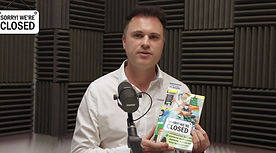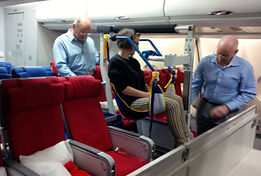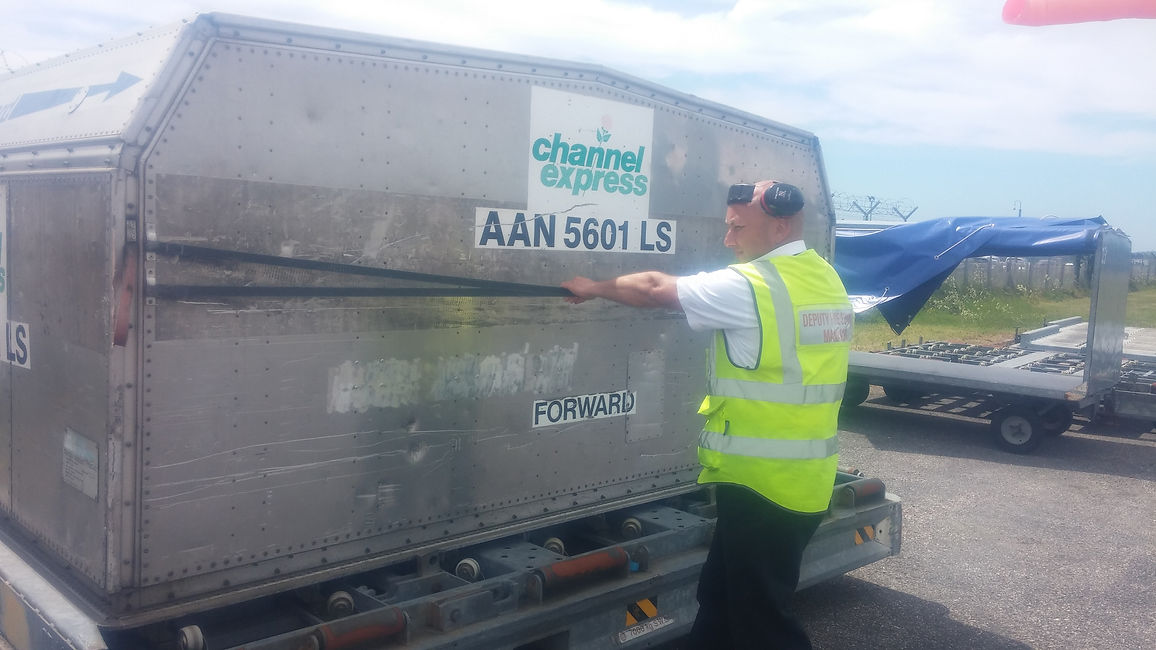
Exeter International Airport
Manual Handling Risk Assessment

Gareth Milner, Director and Manual Handling Consultant for Osteopathic Solutions Ltd visited Exeter International Airport (EIA) in 2016 to gather information on all manual handling tasks and provide solutions to help minimise the risk of Musculoskeletal Disorders (MSDs) in the workforce. Exeter International Airport is owned by Regional & City Airports and employs around 260 full time staff, including Administrative, Air Traffic Control, Passenger Services, Baggage Handlers, Fire Services, General and Aircraft Cleaning, Refuelling, Mail Services, Engineering and Catering staff.
The following case study does not represent our Risk Assessment Report and merely gives the reader an idea of tasks, loads and environments and some (not all) of the MSD risk reduction measures we have recommended to EIA.
Baggage handling in confined spaces (as shown in the photo to the right) totally enforces hazardous manual handling postures for the musculoskeletal system. Plane holds that allow either a squat position or a standing position significantly lower the risks of MSDs, however in the airline industry of cheap flights an enforced kneeling position is commonplace. This is one of those manual handling tasks that will always be high risk for MSDs, however simple measures such as job rotation, knee pads and lumbar supports and fast tracking employees with acute MSDs into physical therapy (Osteopathy, Chiropractic or Physiotherapy) will reduce the potential lost time impact of this high risk task.

Manual Handling training will have no affect on this hazardous task. As our team of Manual Handling Experts are practising Osteopaths, a Back Care ‘Core Stability’ Consultancy was recommended to EIA to help stimulate employees to start a routine exercise plan outside of work. Employees with poor core stability performing this role would be more likely to suffer from lower back injuries.
Loading the Baggage Bins from the plane conveyor was mainly conducted by 2 EIA staff. Bags on the conveyor were generally taken off with the handler facing the load i.e. not twisting the spine. The initial lift is low risk for musculoskeletal strain as the load is being lifted from waist height. The issue with the task was the lower and/ or throw into the baggage bin. Due to the quick (but not excessively at EIA) transfer of the bags from the plane to the baggage bin, the lowering and/ or throwing of the bags was performed with a consistent forward bend of the spine and twist with the furthest leg from the bin coming off the ground with the weight of the body (and load) on the nearest knee to the bin with the knee also twisted.

An even more awkward part of this role involved the bags at the back of the baggage bin (as shown in the photo to the left). Due to the time constraints of a quick turnaround of planes the rear of the baggage bin was closed off. There is significant strain to the neck and shoulders performing this task of stacking bags at the back of the bin. Reducing the MSD risks involves encouraging the employees (through task specific Manual Handling training) to move their feet more and place the bags into the bins without a spinal twist, so that they are performing a pure forward bend (as shown in the below slideshow), keeping both feet on the ground.
Forward bending (or stooping) is well known for causing back injuries however this posture in this task is far less hazardous for the lower back compared with a forward bend and twist. Placing one foot onto the baggage bin’s base (shown in the below slideshow) will allow the person to handle the bag at the back of the bin with an improved posture. Realistically this practice would be difficult to engrain in the employees’ practice but this represents safer manual handling.
As shown in the video to the left, their tasks included lifting and throwing airplane balancing weights from the plane conveyor to the white vehicle. At 25 seconds on this video, the employee (in the orange hi vis) is throwing a 25kg bag twisting his trunk to the left to take it off the conveyor (with a twist of the neck to the right) with him then throwing the bag with high force with a rapid twist of the trunk and lower extremities to the right. This practice is high risk for spinal and knee MSDs. Simply facing the load when picking off the conveyor and moving the feet to face the vehicle when placing the bag on it will make this task significantly less risk for MSDs.
Transferring the Baggage Bins commonly involved 2 employees at a time (as shown in the video to the right), weighing up to a total of 2000kg. This is a machine task, not a human task as the tugs should be used as much as is possible. However in the real world there will always be manual handling of loads as a tug may not be available.
Other Baggage Handling tasks assessed included loading luggage onto planes from the plane conveyor; handling out of gauge items; transferring luggage from the baggage bins to the conveyor and security screening of passenger luggage.
One of the highest risk tasks for MSDs across EIA involves the manual lift of a Passenger with Reduced Mobility (PRM) by 2 Fire Services male employees from a wheelchair to a Columbia chair and from a Columbia chair onboard the plane to the passenger’s seat. This task was not viewed on the day due to no PRMs on the day's flight. The video to the left demonstrates the task. This practice is still commonplace across Aviation Passenger Services companies across the UK, due to its lack of equipment need and relative speed of task completion. However, the task is extremely high risk for serious and long standing spinal injuries including neck and lower back disc herniations, lower back disc prolapse as well as leading to severe symptomatic spinal degeneration.
Inside the plane the confined space and need to lift over arm rests enforces the person holding the PRM's legs to severely twist their spine and hold the (heavy and awkward) legs away from their (the handler) body, as well as the unavoidable forward bent lifting and lowering practice. The handler behind the PRM had to backward bend their spine to lift and transfer the PRM. There is also an airline requirement of putting the PRM next to the window because in an emergency this allows 2 people in a seating row to get out from their chairs quickly. This adds additional environmental factors in this very high risk task for MSDs. Aside from the obvious task MSD risks this way of transferring the PRM is undignified and may likely cause emotional and physical harm to the PRM.


Diagrammatic & MRI scan images of a Prolapsed Lumbar (Lower Back) Disc

4 solutions were presented within our report. These included an Aviation Hoist as shown in the left photo. Our 4th solution involved the use of moderate cost moving & handling of people aids and equipment used in the UK care setting. Within our report (as we are specialists in Moving & Handling of People training) practical skills training in the techniques and use of this handling equipment was recommended with our Bath based trainer Paul Henaghan, onsite at EIA.

At EIA (as of 2016) PRMs are transferred to and from the Columbia chair at the top of the Aviramp (as shown in the photo to the left). To remove this manual lift and lower a mobile hoist as used in the care setting was recommended. This would however need EIA investment in an Ambulift (as shown in the photo to the right).

The manual handling/ moving & handling of people tasks involving the Aviramp for the Passenger Services employees involved:
-
Pushing PRM from airport tarmac up Aviramp to aircraft door
-
Pushing/ transferring PRM down Aviramp to airport tarmac
-
Physical assistance of passengers in walking up and down the Aviramp
Currently a manually pushed wheelchair was used to transfer the dependent PRM on and off the plane. Staff understood that it was reasonable practice to pull from the front of the wheelchair low down with their colleague pushing from behind. This involved an extreme forward bend of the spine to contact the wheelchair to pull. A high risk posture for MSDs to the neck, lower back and shoulder (contacting the wheelchair). Powered wheelchairs were recommended as soon as possible. With safer, more powerful and biomechanically efficient technique in pushing loads performed by EIA passenger services staff this would reduce the strain with the current manual transfer of staff on the Aviramp. Task specific training was recommended with our trainer Paul Henaghan.
The employee featured in the video to the left carried a chock (which weighed around 25kg) the approximate distance of 40 metres from the plane to the area where the Aviramp and tugs were positioned on the airport tarmac. He carried the chock with one arm. This will cause musculoskeletal strain to the right shoulder, the neck and lower back. The employee then lowered the chock with (an unenforced) natural practice involving a side bend and twist of the spine, a position of the spine that strains the lower back discs. Concerning safer carrying of loads please refer to our Instructor CPD Course Case Study at EIA on this link.
Many natural manual handling practices involve an element of operator laziness and this is one. The dragging of the cone behind the body, with the shock coming up through the right arm will cause musculoskeletal strain to the neck and right shoulder. This is totally avoidable and safer lifting of cones (shown on our EIA Instructor CPD Course Case Study on this link) and carrying practice should be performed by Ground Operations and Passenger Services employees.

A single person transfer of the 2.5 tonnes (2500kg) Aviramp was observed across the airport tarmac. Within the Manual Handling Operations Regulations the maximum guideline weight for a single operator on a flat (factory type) floor is 1 tonne (1000kg) for pushing and pulling. Within many industry settings (especially manufacturing) our consultants consistently see employees pushing and pulling over 1000kg. Within our 49 page report for EIA this task of transferring the Aviramp was recommended to be a 2 person operation, and if not, ways of transferring it with a ground powered unit were recommended to be looked into.
The fuelling of planes had a specialist crew of operators, fuelling up to 30 planes per day by the 2-3 employee team. With the task of connecting the fuel hose to the plane, no manual handling training will reduce the risk of MSDs as biomechanically safe posture is simply not possible. The repetitiveness during the working day of holding the arms in up to 135° - 160° of shoulder flexion will cause musculoskeletal strain to the forearm, shoulder and neck structures. EIA staff had access to a contracted out Chiropractic service, and appropriate department management of this service would reduce employee lost time associated with this task of necessity.

The mobile fuelling steps were pulled by 1 person, a maximum distance of 10 metres. Due to its very heavy weight a 2 person transfer was recommended in our report to reduce MSD risks.
In the distribution and bakery sectors it is common for employees to pull 2 cages at a time (with reference to this please view our Bespoke Manual Handling Training DVD for Roberts Bakery). Pulling with bodyweight, a forward bend and twist of the spine is one of the most hazardous manual handling practices and will lead to musculoskeletal strain across the body leading to possible neck, shoulder, upper limb and knee MSDs. It was recommended that these mail cages should be handled one at a time and preferably pushed.

The task shown below was not operational on the consultancy day. The task of moving the load over the wheels was informed to me to be very awkward, commonly jamming along the track. Due to the weight of up to 3000kg the task was recommended to always be a team handling operation.
Other departments where task assessments were conducted were within the Engineering and Fire Services teams. Engineering tasks were generally lower risk as were the Fire Services’ tasks (aside from their non standard baggage handling role).
EIA’s current training was also assessed. EIA had 2 trained Manual Handling Instructors (please view our Instructor CPD Course Case Study on this link. A mixture of power point, video and classroom based practical training was provided.

At the time of the consultancy, the Child's Play Manual Handling video was included in EIA's in house training. The only real benefit this video gives is that it shows attendees that young children lift and lower loads with a squat. Concerning squat lifting technique, the video is significantly biomechanically flawed, and therefore we recommended that this video was not used. The classroom powerpoint was also recommended for improvements. Although overall in line with HSE manual handling guidelines, biomechanically flawed practice in squat lifting and lowering was being taught.
Overall a comprehensive assessment of all EIA manual handling operations and training, aimed at driving down workforce MSDs and lost time, with our onsite consultancy and report only at the cost of around 4 lost employee work days.






